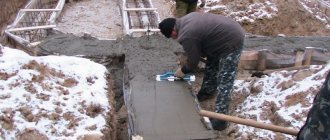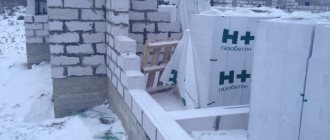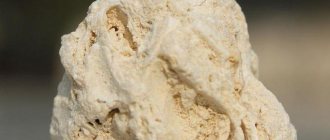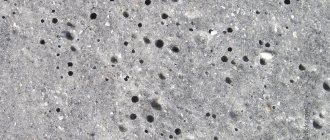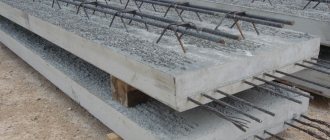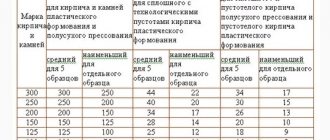It is impossible to imagine the construction of buildings and the construction of reinforced concrete structures without the use of concrete. Different brands of composite differ in performance characteristics. It is able to withstand increased loads, but external factors cause its destruction. One of the most important parameters that determine the stability of erected buildings and the duration of their operation is the elastic modulus of concrete. Its value is influenced by a number of factors. Let us consider in detail the parameter characterizing the ability of concrete to withstand compression and tension.
It is impossible to imagine the construction of buildings and the construction of reinforced concrete structures without the use of concrete
The modulus of elasticity of concrete structures is an important parameter
The modulus of elasticity of concrete, which characterizes the ability of a mass to maintain integrity under the influence of deformation, is used by designers when performing strength calculations of building structures. The main distinguishing feature of concrete products and structures is hardness. At the same time, the impact of a load whose magnitude exceeds the permissible values causes compression and tension of the composite. The hardened monolith changes during deformation. The reason is the creep of the material.
Depending on the value of the creep coefficient and the magnitude of the applied load, the structure of the monolith changes gradually:
- At the first stage of application of the load, a short-term change in the structure of the concrete occurs. It maintains integrity and restores its original condition. Tensile and compressive forces, as well as bending moments, cause elastic deformation without irreversible damage;
- at the next stage, with a sharp increase in load, irreversible damage occurs. As a result of plastic deformation, deep cracks appear, which subsequently cause the gradual destruction of buildings and various concrete structures.
The elasticity coefficient is the main characteristic that determines the strength properties of concrete. The indicator is of interest to professional designers involved in calculating the load capacity of concrete structures. Individual developers should focus on the class of material, with an increase in which the value of the elastic modulus of concrete increases.
The elasticity coefficient is the main characteristic that determines the strength properties of concrete
Rheological properties of concrete mixture
A concrete mixture is a rationally composed and thoroughly mixed mixture of concrete components before the setting and hardening processes begin. The composition of the concrete mixture is determined based on the requirements for the mixture itself and for the concrete.
The main structure-forming component in a concrete mixture is cement paste. Regardless of the type of concrete, the concrete mixture must satisfy two main requirements: have good workability, corresponding to the compaction method used, and maintain the homogeneity achieved during preparation during transportation and placement. Under the influence of increasing force, the concrete mixture first undergoes elastic deformation, but when the structural strength is overcome, it flows like a viscous liquid. Therefore, the concrete mixture is called an elastic-plastic-viscous body, which has the properties of a solid and a true liquid. The property of a concrete mixture to liquefy under mechanical stress and thicken again in a calm state is called thixotropy.
What factors determine the modulus of elasticity of concrete B25 and concrete of other classes
The value of the elastic modulus is influenced by the following factors:
- filler characteristics. The value of the indicator is directly proportional to the specific gravity of concrete. At low density, the elastic modulus value is less than that of heavy, fine-grained building materials containing dense gravel or crushed stone filler;
- classification of concrete. Each concrete strength class has its own elastic modulus value. As the class of concrete increases, the value of the elastic modulus simultaneously increases. The initial value of the elastic modulus of class B10 concrete is 19, and for B30 concrete it is 32.5;
- age of the monolith. The value of the parameter characterizing the elasticity of the material and the duration of operation are directly related. It has no limit of proportionality - with increasing age of concrete, the strength of the concrete structure increases. Using existing tables, specialists determine the required value taking into account correction factors;
- technological features of concrete production. The concrete production technology provides for processing at atmospheric pressure and the possibility of hardening of building materials in natural conditions, as well as in autoclaves under the influence of increased pressure and high temperature. The conditions under which the concrete hardened affect the indicator;
- duration of concrete being under load. The elastic resistance modulus is calculated by multiplying the table value by the correction factor. For cellular concrete with a porous structure, the value is 0.7; for dense concrete – 0.85;
Modulus of elasticity of concrete of different classes
- moisture concentration in the air. Depending on air humidity, the moisture concentration in concrete changes, which affects its ability to withstand maximum loads. Ambient temperature also affects the elastic modulus value;
- the presence of a spatial lattice made of reinforcing bars. Reinforcement increases the ability of a concrete mass to resist destructive deformations and absorb acting loads. The design resistance for the reinforcement is specified in the regulatory documents.
The module depends on a complex of factors. They should be taken into account when performing strength calculations. Regardless of the elasticity of the mass, remember that the presence of a reinforcement grid significantly increases the resistance of concrete to existing loads.
For reinforcement, use high-class fittings. Do not forget that the standard resistance value for class A6 fittings is higher than the resistance value for class A1 fittings.
Types of solution
All such materials are divided into several types. The most interesting thing is that not even all professional builders know that there are several types of concrete:
- Heavy. This type is marked M100, M150, M200, etc. The mixture contains dense fillers limestone and granite. Heavy concrete is highly durable. It hardens quickly, so its main purpose is prefabricated reinforced concrete structures.
- Lungs. Light porous fillers such as expanded clay, pumice, expanded slag and others are added to such concrete during production. Thanks to this composition, the material becomes much lighter, so it is used for the construction of load-bearing walls and other enclosing structures.
Lightweight products are also porous, large-porous and cellular. They differ in their composition and scope of application.
Modulus of elasticity of concrete - table
The coefficient characterizing the elasticity of the material remains unchanged up to a certain temperature threshold. The table will help you trace the dependence of changes in the elastic modulus on the grade of material and temperature conditions. For example, for materials with a melting point of 300 °C, after further heating, the ability to resist elastic deformation decreases. And although concrete does not melt, under the influence of elevated temperatures caused by a fire, the structure of the concrete mass is disrupted and it loses its properties.
Modulus of elasticity of concrete - table
The table developed in accordance with Code of Practice 52 101 2003 will help determine the value of the initial elastic modulus for various classes of concrete:
- the elasticity index for material class B3.5 is 9.5;
- building material of class B7.5 is distinguished by an increased modulus value of 16;
- building material of class B20 with natural hardening has a modulus value of 27;
- concrete classified as B35 has an elastic modulus increased to 34.5;
- the maximum value of parameter 40 corresponds to durable concrete class B60.
Knowing the class of the material, as well as having information about the density of the building material and manufacturing technology, it is easy to determine the value of the parameter using a special table.
Factors affecting Young's modulus
Young's modulus is the main characteristic of concrete that determines its strength. Due to its size, designers carry out calculations of the material’s resistance to various types of loads. The indicator is influenced by many factors:
- quality and quantity of aggregates;
- concrete class;
- air humidity and temperature;
- time of exposure to load factors;
- reinforcement.
PHOTO: dostroy.com The modulus of elasticity allows designers to correctly calculate the load
Quality and quantity of aggregates
The quality of concrete depends on its aggregates. If the components have low density, accordingly, Young's modulus will be small. The elasticity of the material increases several times if heavy fillers are used.
PHOTO: russkaya-banja.ru Large components increase elasticity characteristics
PHOTO: ivdon.ru Graph of the dependence of the tensile strength of a material on cement stone
Material class
The class of concrete also influences the coefficient: the lower it is, the lower the value of the elastic modulus. For example:
- the elastic modulus of B10 corresponds to a value of 19;
- B15 – 24;
- IN 20 – 27.5;
- B25 – 30;
- the indicator for B30 increases to a value of 32.5.
PHOTO: buildingclub.ru Dependence on concrete class
How do humidity and temperature values affect the indicator?
The increase in deformations and decrease in the elastic properties of the material are influenced by:
- increase in air temperature;
- increase in solar activity.
Under the influence of negative environmental factors, the internal energy of the material increases, this leads to linear expansion of concrete and, accordingly, to an increase in plasticity.
Important! A decrease in temperature fluctuations from 20 °C is not taken into account in the calculations.
The creep of the material is affected by moisture, leading to a change in elastic characteristics. The higher the water vapor content, the lower the coefficient.
How is the elastic modulus of concrete B20 determined?
The modulus value for all classes of material is determined in accordance with SP 52 101 2003. The table of the normative document contains the values of all the necessary coefficients for performing calculations. The algorithm for determining the indicator involves performing experimental studies on standard samples.
Diagram of elastic modulus of concrete B20
In the specialized literature, the parameter is denoted by the capital letter E and is known among professional designers as Young’s modulus.
It has different values depending on the effective load and the structure of the concrete:
- the value of the initial modulus of elasticity corresponds to the initial state of concrete, which accepts plastic deformation without cracking of the mass;
- the reduced value of the elastic modulus characterizes the loading stage, after which the concrete loses its integrity as a result of irreversible destruction.
Carrying out special calculations and knowing the value of the modulus of elasticity, specialists determine the safety factor of arch-type structures, road and railway bridges, as well as building floors.
After the construction of a structure or structure, it is actually possible to conduct reliable comprehensive tests of concrete for strength, frost resistance, humidity and moisture permeability only in the laboratory. Within the framework of non-destructive testing, it is possible to roughly determine the class of concrete using ultrasonic diagnostic methods.
And if, after such an expert examination of the sample, doubts arise about the unambiguous classification, then to assess the strength characteristics of concrete, a sample is taken - a core - directly at the construction site. To practically determine the elasticity coefficient of the material and provide actual documentary evidence, an independent examination of concrete is carried out.
Very often, unscrupulous contractors save money on materials and do not purchase/use concrete of the class specified by the project at the site. As a consequence, a lower modulus of elasticity leads to premature destruction of the structure.
Technical properties of concrete mixture
In the manufacture of reinforced concrete products and concreting monolithic structures, the most important property of a concrete mixture is workability (or workability), i.e. the ability to fill the mold with this compaction method while maintaining its uniformity.
To assess workability, three indicators are used: mobility of the concrete mixture (P), which is a characteristic of the structural strength of the mixture; hardness (R), which is an indicator of the dynamic viscosity of the concrete mixture; cohesion, characterized by water separation of the concrete mixture after it has settled.
The workability of a concrete mixture is characterized by the measured settlement (cm) of a cone (OC) formed from the concrete mixture to be tested. The mobility of a concrete mixture is calculated as the average of two determinations made from one sample of the mixture. If the cone settlement is zero, then the workability of the concrete mixture is characterized by rigidity. The stiffness of a concrete mixture is characterized by the time (s) of vibration required to level and compact the preformed cone of the concrete mixture in a stiffness tester.
Recommendations
Professional builders recommend using various manufacturing technologies to increase the elastic modulus. Let's look at how the properties of B15 concrete produced by various methods change:
- as a result of autoclave treatment, concrete acquires elastic properties characterized by a modulus of 17;
- the use of heat treatment performed at atmospheric pressure makes it possible to increase the elastic modulus to a value of 20.5;
- The maximum modulus value for concrete is 200 M (B15) under natural hardening conditions.
Various concrete manufacturing technologies
A similar trend can be seen for other classes of concrete, including the popular b25 concrete.
From this point of view, the following trends can be traced:
- to increase the elastic modulus of concrete, it is advisable to use natural hardening technology;
- the use of hydrothermal treatment reduces the ability of the material to resist compressive and tensile loads;
- As the class of concrete used increases, its resistance to elastic deformation increases.
Using table values, it is easy to determine the modulus of resistance and select the class of concrete to perform specific tasks.
Methods for defining a module
The elastic modulus of concrete is determined based on the results of an experiment with a concrete sample. A concrete block in the form of a cylinder of certain dimensions is placed under a hydraulic press and the load is turned on. At the same time, the elastic modulus is determined by the devices connected to the press and by the appearance of the blank.
Another method allows you to measure the density of concrete, and through it determine the elastic modulus using a special portable device.
- A device called a concrete strength testing hammer is applied to the concrete.
- Working like an electric jackhammer, the device, through a special tip, delivers light blows to the place to which it is applied.
- After a certain time, the value of those concrete characteristics that are included in the device program appears on the device screen.
The hammer software allows you to store up to 25 measurements in memory.
Workability of concrete mixture
The amount of mixing water is the main factor determining the workability of a concrete mixture. Mixing water (B, kg/m3) is distributed between the cement paste (Vc) and the aggregate (Vzap): B = Vc + Vzap. The amount of water in the cement paste is determined by its rheological properties: ultimate shear stress and viscosity, and, consequently, the technical properties of the concrete mixture - mobility and rigidity.
The water requirement of Vzap aggregate is its important technological characteristic; it increases with an increase in the total surface of the filler grains and is therefore large for fine sands. To ensure the required strength of concrete, the water-cement ratio must remain constant, therefore an increase in water demand causes excess consumption of cement. With fine sands it reaches 15-25%, so fine sands should be used after enrichment with coarse natural or crushed sand and with plasticizing additives that reduce water demand
Classification of concrete mixtures
The cohesiveness of the concrete mixture determines the uniformity of the structure and properties of concrete. It is very important to maintain the homogeneity of the concrete mixture during transportation, placement in the form and compaction. When compacting moving concrete mixtures, the constituent grains come together, and some of the water is pressed upward. Reducing the amount of mixing water when using plasticizing additives and increasing the water-holding capacity of the concrete mixture by correctly selecting the grain composition of aggregates are the main measures to combat the separation of moving concrete mixtures.
Thermophysical properties of concrete
Thermal conductivity is the most important thermophysical characteristic of concrete, especially used in building envelopes.
The thermal conductivity of heavy concrete in an air-dry state is 1.2 W/(m°C), i.e. it is 2-4 times greater than that of lightweight concrete (on porous aggregates and cellular). High thermal conductivity is a disadvantage of heavy concrete. External wall panels made of heavy concrete are made with an inner layer of insulation.
The heat capacity of heavy concrete varies within a narrow range of -0.75-0.92 W/(m.C°). The linear coefficient of thermal expansion of concrete is about 0.00001 °C, therefore, with an increase in temperature by 50 °C, the expansion reaches approximately 0.5 mm/m. To avoid cracking of large structures, they are cut with temperature-shrinkage seams.
The coarse aggregate and mortar that make up concrete have different coefficients of thermal expansion and will deform differently as temperatures change.
Large temperature fluctuations (more than 80°C) can cause internal cracking of concrete due to different thermal expansion of coarse aggregate and mortar. Characteristic cracks propagate along the surface of the aggregate, some of them forming in the solution and sometimes in weak aggregate grains. Internal cracking can be prevented if care is taken to select concrete components with similar thermal expansion coefficients.
